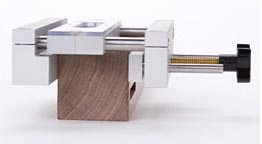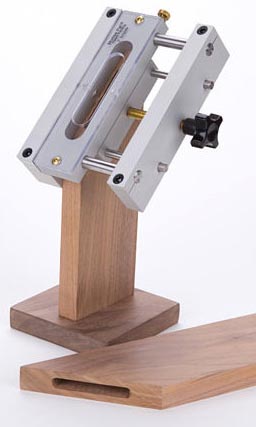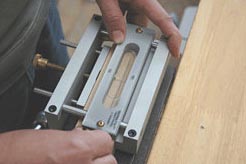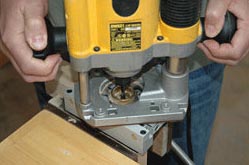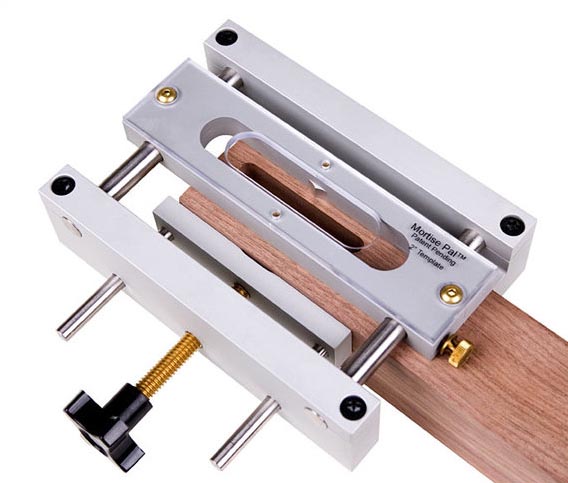
My guess would be that just about every woodworking magazine has, at one time or another, offered plans for a homemade mortising jig. But unless you have made a lot of mortises, and a lot of jigs, building a good, accurate jig is a lot harder than it seems. That’s why I appreciate people like Rob Gill, the designer and creator of Mortise Pal, a beautifully made and astonishingly simple to use mortising jig.
Of course, Rob did not start out as a tool designer. “Right out of high school, I joined the Marine Corps,” he recounted, “and spent five years there. After getting out, I worked a variety of jobs and took classes at a community college. Eventually, I stumbled onto electronics, and got an associate degree in the subject. That got me into real world work in engineering labs helping develop products, which inspired both interest and insight into the mechanics of things.
“Woodworking had always intrigued me and had a romantic appeal, so I took it up as a hobby in 2001. My grandfather was a hobby woodworker, and my father had been a shop teacher in the school system, but oddly, I never got into it as a kid. Perhaps, though, it was in my genes.
“Working on projects out of magazines, I soon became frustrated with the inaccuracy of both tools and methods. Mortising in particular was a problem; I found most shop-made jigs and hollow chisel mortisers made it difficult to locate mortises accurately. I had been used to holding tight tolerances in metalworking, but found it almost impossible using woodworking tools and wood. After looking at both homemade and commercial options, I decided that either the jigs were under-built or overpriced.
“While working on a project that required accurate mortises, I found myself getting obsessed with designing a tool that I would have liked to have been able to buy. First, I developed a jig that perfectly centered a mortise on a board, but found that was too limiting. It was neat, but not all mortises should be centered. Over three years, I worked through a few other iterations and came up with the Mortise Pal.
“Oddly, it was inspired by an old-style doweling jig along with other fixtures that paired plunge routers and bushings. As a result, when I started to expand the jig’s capability, I adapted it to also work as a doweling jig. Once loose tenon joinery got a big boost with the introduction of the Domino®, which came while I was midway through development, it confirmed to me that there was a market for loose tenon joinery as well. My jig is perfect for that as well. In fact, I have seen it called the ‘poor man’s Domino. The fact that loose tenon stock is now widely available was a real boon. All I had to do was offer cutters that fit both the standard tenon sizes and standard American router shaft sizes. As luck would have it, Whiteside was already doing that.
“I was a bit apprehensive when I first took it to Palomar College to show it off. Fortunately, the first instructor I showed it to was very impressed by it, and that encouraged me to pursue it further. As I made more modifications, I got feedback as well as encouragement. About a year and a half ago, I quit my job to devote myself full-time to Mortise Pal.
“At present, Mortise Pal, which first went on sale in December 2007, is only sold through my website. I handle all day-to-day operations personally, and have outside machine shops here in California manufacturing certain parts for me. However, I am currently in the process of moving all manufacturing in-house so that I can continue to ensure the quality of the parts.”
What sets Mortise Pal apart from its competitors? “I made it for me,” Rob explained, “so it is made for someone looking for accuracy. It works with all plunge routers, though in the user’s manual I suggest avoiding really large ones. In my experience, the lighter the router, the easier it is to control. Mortise Pal is compact, easy to use, lightweight, accurate, and possibly most importantly, it is intuitive. Take one look at it and it is obvious how it works even before you read the instructions.”
I can’t think of a more important characteristic for those of us who, like me, read instructions only as a last resort. For that alone we’d lift our glasses in thanks, but the fact that such simplicity comes paired with high quality and versatility leaves us even more grateful.
Excuse me. I think I want to go cut some mortises.
